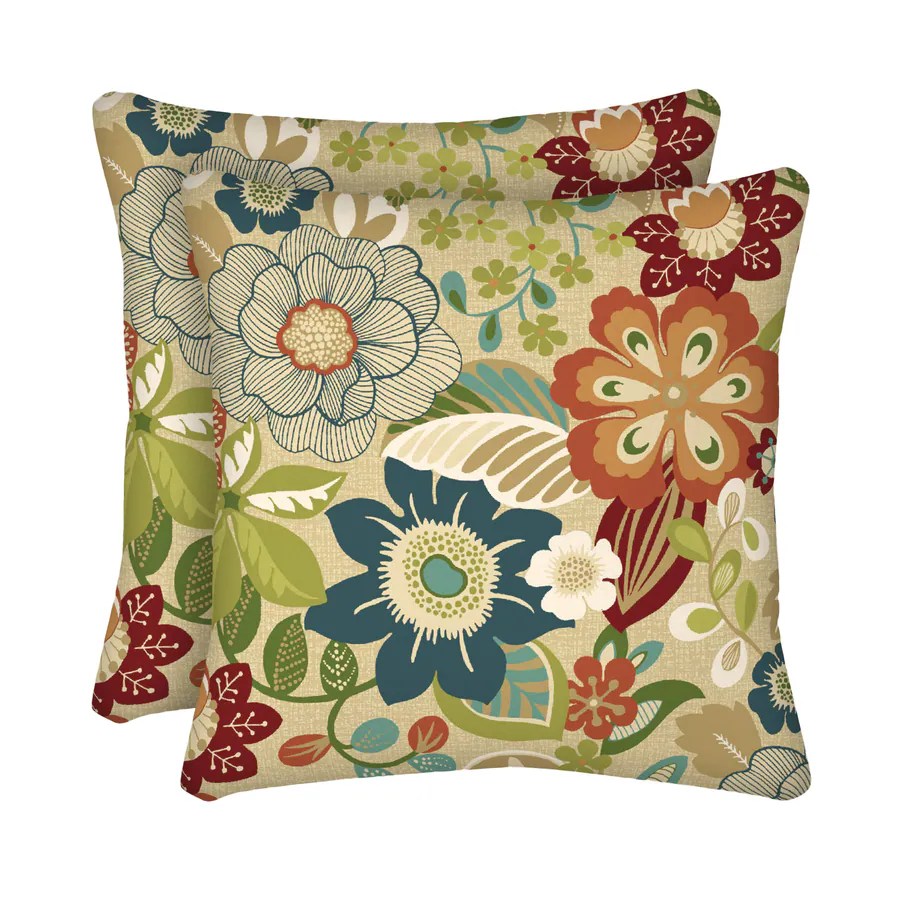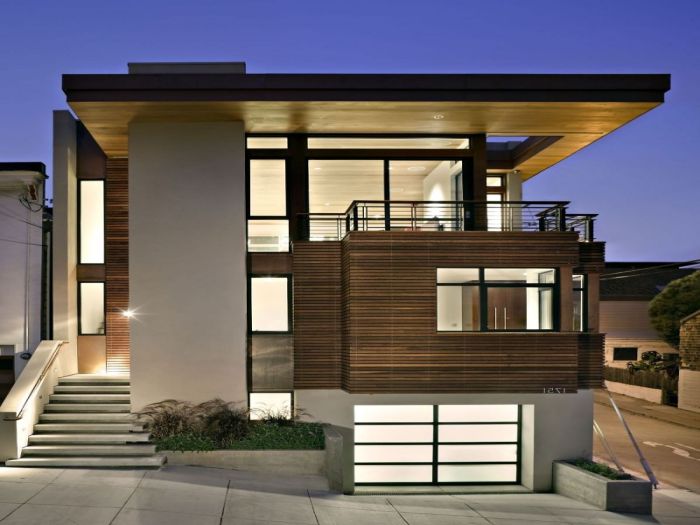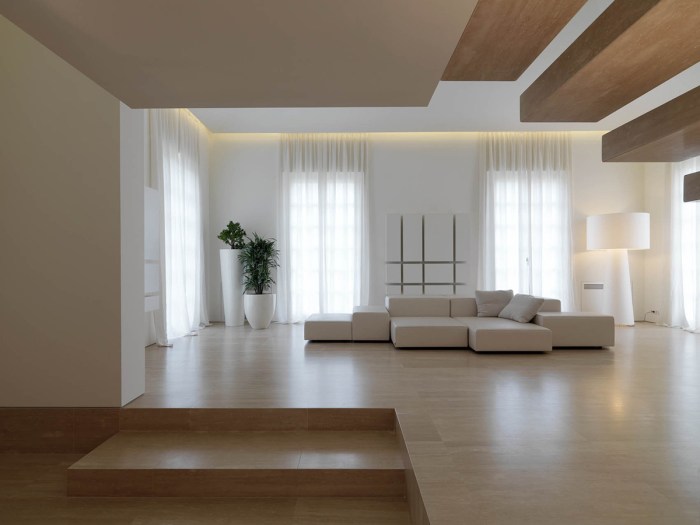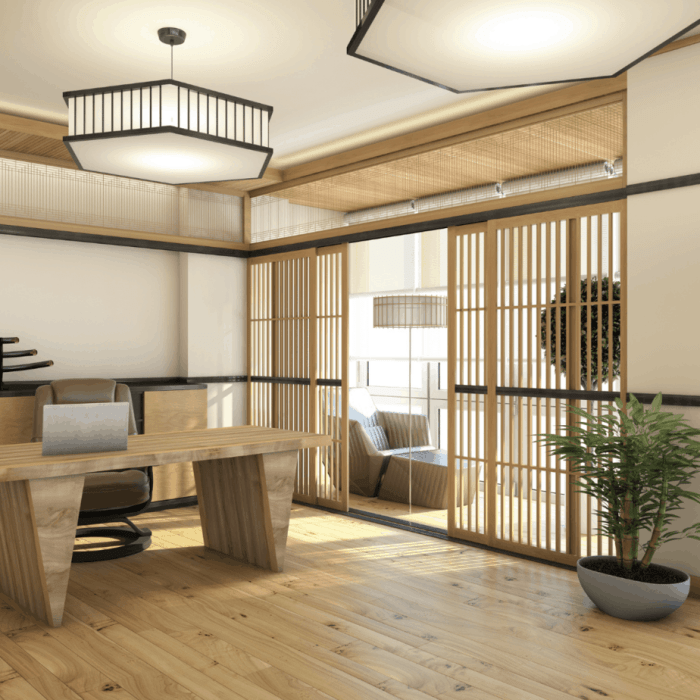Scandinavian bedroom design, renowned for its minimalist elegance and connection to nature, offers a haven of tranquility and restorative sleep. This style prioritizes functionality, natural light, and a calming color palette, leveraging principles of biophilic design to create spaces that promote well-being. We’ll delve into the key elements – from carefully curated color palettes and the strategic selection of furniture to the masterful use of natural light, textures, and carefully chosen textiles – to illuminate how to craft a Scandinavian sanctuary.
The psychological impact of color and texture on sleep and relaxation will be explored, grounding our design choices in scientific understanding of human-environment interaction.
This exploration will move beyond mere aesthetics, examining the practical considerations of lighting design and furniture placement to optimize both functionality and ambiance. We’ll investigate how different lighting styles, from ambient to task lighting, contribute to a balanced and inviting atmosphere. The incorporation of natural materials, such as wood and wool, will be highlighted for their tactile and visual appeal, underscoring their role in creating a space that is both aesthetically pleasing and conducive to rest and rejuvenation.
Finally, we will examine distinct variations within the Scandinavian aesthetic, showcasing the versatility of this design approach.
Color Palettes in Scandinavian Bedrooms
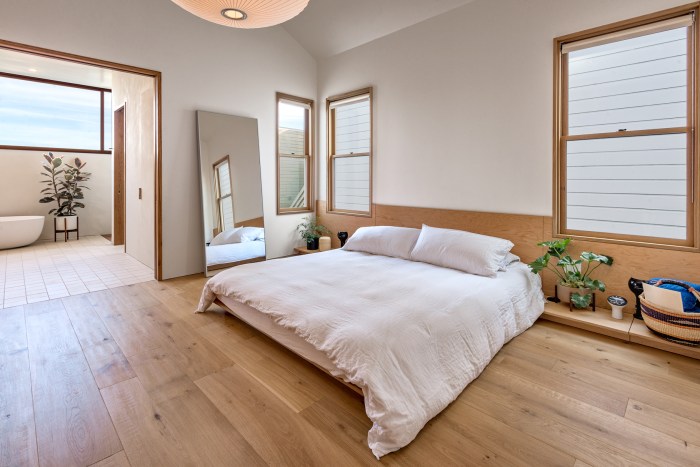
The Scandinavian design aesthetic, renowned for its minimalist elegance and emphasis on natural light, translates beautifully into the bedroom. Color palettes play a crucial role in achieving the desired atmosphere of calm and serenity. By carefully selecting shades of white, natural tones, and subtle accents, one can create a space that promotes restful sleep and enhances overall well-being.
The psychological impact of color on sleep is well-documented, with cooler tones generally being preferred for their calming effect.
Scandinavian Bedroom Color Palettes
Three distinct color palettes are presented below, each designed to evoke a different mood within the Scandinavian style framework. The selection of colors considers the impact of hue on the human psyche, specifically focusing on promoting relaxation and sleep quality. Chromotherapy, the use of color to influence mood and well-being, suggests that certain colors are more conducive to sleep than others.
Palette 1: Serene Snowdrift
This palette emphasizes a sense of airy spaciousness and tranquility. It utilizes variations of white to create depth and texture without overwhelming the space.
| Color Name | Hex Code | Mood Description |
|---|---|---|
| Off-White | #F8F8FF | Creates a sense of airy spaciousness and cleanliness. |
| Warm White | #FAEBD7 | Adds subtle warmth and prevents the space from feeling sterile. |
| Light Grey | #D3D3D3 | Provides a neutral backdrop and adds visual interest. |
| Natural Linen | #FAF0E6 | Introduces a touch of warmth and natural texture. |
The psychological effect of this palette leans heavily on the calming properties of white and light grey. White, often associated with purity and cleanliness, can create a feeling of spaciousness, while light grey adds a touch of sophistication without being overly stimulating. The inclusion of a warm, natural linen tone counteracts any potential coldness, contributing to a feeling of comfort and coziness.
Research suggests that cool, neutral tones promote relaxation and improved sleep quality.
Palette 2: Misty Fjord
This palette evokes the serene beauty of a Scandinavian fjord, blending cool blues with warm neutrals.
| Color Name | Hex Code | Mood Description |
|---|---|---|
| Soft Blue | #ADD8E6 | Creates a calming and peaceful atmosphere. |
| Cloud White | #FFFFFF | Provides a bright and airy base. |
| Light Oak | #F5F5DC | Introduces warmth and natural texture. |
| Silver Grey | #C0C0C0 | Adds subtle sophistication and depth. |
The combination of soft blue and cloud white promotes a sense of tranquility and spaciousness. Blue, known for its calming effect on the nervous system, is often recommended for bedrooms to aid sleep. The addition of light oak and silver grey provides a balance, preventing the palette from becoming too cold or monotonous. This balanced approach, combining calming blues with warming neutrals, aligns with the principles of chromotherapy to create a restful environment.
Palette 3: Golden Hour Glow
This palette utilizes warm whites and soft yellows to create a welcoming and inviting atmosphere.
| Color Name | Hex Code | Mood Description |
|---|---|---|
| Creamy White | #FFF8DC | Provides a warm and inviting base. |
| Pale Yellow | #FFFFE0 | Adds a touch of warmth and sunshine. |
| Beige | #F5F5DC | Creates a neutral backdrop and complements the warmer tones. |
| Light Walnut | #8B4513 | Introduces a grounding element and adds depth. |
The warm tones of this palette promote feelings of comfort and security. Pale yellow, associated with optimism and happiness, can create a cheerful atmosphere without being overly stimulating. The creamy white base prevents the yellow from being overpowering, while the beige and light walnut tones ground the palette, creating a sense of balance and stability. While warm colors are generally less conducive to sleep than cool colors, the muted and soft variations in this palette ensure a gentle and inviting atmosphere suitable for relaxation.
Furniture Selection for a Scandinavian Style
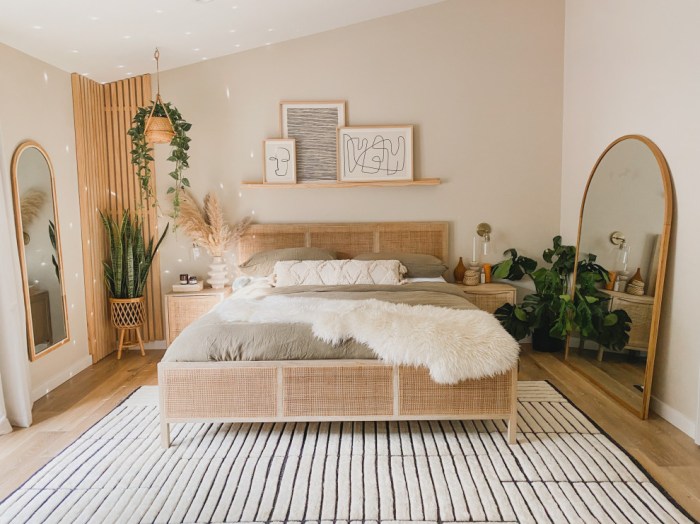
The Scandinavian design philosophy prioritizes functionality, minimalism, and natural materials, creating serene and inviting spaces. Translating this philosophy into bedroom furniture requires careful consideration of both form and function, emphasizing pieces that are both aesthetically pleasing and practically useful. The key lies in selecting furniture that maximizes space while maintaining a sense of calm and order.
Scandinavian bedroom furniture is characterized by its clean lines, simple forms, and a focus on natural materials. This aesthetic is rooted in the region’s history and climate, where practicality and resourcefulness are highly valued. The use of light wood, natural textiles, and muted color palettes contributes to the overall feeling of airy spaciousness and tranquility.
Essential Furniture Pieces for a Scandinavian Bedroom
A well-designed Scandinavian bedroom incorporates a carefully curated selection of furniture pieces, each serving a specific purpose and contributing to the overall aesthetic. Over-furnishing is avoided, emphasizing instead the quality and functionality of each piece.
- Bed Frame: A simple, low-profile bed frame made of light-colored wood, such as pine or birch, is a staple. The design is typically unadorned, focusing on clean lines and a natural finish. The bed should be large enough to ensure comfort and relaxation but should not overwhelm the room.
- Nightstands: Two small, matching nightstands flank the bed, providing convenient surfaces for lamps, books, and other personal items. These are often made from the same wood as the bed frame, maintaining visual consistency.
- Wardrobe or Closet: Ample storage is essential, and a built-in wardrobe or a freestanding wardrobe with clean lines and light wood finish is ideal. The wardrobe should be integrated seamlessly into the overall design.
- Dresser or Chest of Drawers: A dresser or chest of drawers provides additional storage for clothing and other belongings. Again, a simple, unadorned design in light wood is preferred. The size should be proportionate to the room’s dimensions.
- Mirror: A large, simple mirror can help to create a sense of spaciousness and enhance the room’s brightness. It can be placed on a wall or integrated into the wardrobe design.
Materials Commonly Used in Scandinavian Furniture
The choice of materials significantly impacts the overall feel and durability of Scandinavian bedroom furniture. Natural materials are favored, reflecting the region’s appreciation for sustainability and environmental consciousness. The careful selection of these materials contributes to the overall aesthetic and longevity of the furniture.
- Wood: Light-colored woods such as pine, birch, and ash are most common. These woods are known for their durability, affordability, and light, airy appearance, which complements the Scandinavian aesthetic. The wood is often left with a natural finish, showcasing its grain and texture.
- Textiles: Natural textiles such as linen, wool, and cotton are frequently used for bedding, curtains, and other soft furnishings. These materials add warmth and texture to the space while maintaining a sense of understated elegance. Neutral colors and simple patterns are typical.
- Metal: While less prevalent than wood and textiles, metal accents, particularly in black or brass, can be incorporated subtly to add a touch of modern sophistication. This might be seen in bed frame details or in the legs of a nightstand.
Example Scandinavian Bedroom Layout
This layout emphasizes functionality and flow, creating a relaxing and aesthetically pleasing space. The placement of furniture maximizes natural light and creates a sense of spaciousness.
- Bed: Centered against the largest wall, allowing ample space on either side for nightstands.
- Nightstands: Placed symmetrically on either side of the bed, providing convenient surfaces for lamps and personal items.
- Wardrobe: Positioned along an adjacent wall, providing ample storage without cluttering the room.
- Dresser: Placed against another wall, opposite the bed, offering additional storage and creating a balanced layout.
- Mirror: Hung on the wall opposite the bed or integrated into the wardrobe design, maximizing light reflection.
- Rug: A natural fiber rug placed under the bed adds warmth and texture, defining the sleeping area.
Incorporating Natural Light and Textures
The Scandinavian design aesthetic, renowned for its minimalist elegance and emphasis on functionality, hinges critically on the strategic use of natural light and the incorporation of natural textures. The long, dark winters of Scandinavia necessitate a design philosophy that maximizes available daylight and creates a sense of warmth and comfort through carefully chosen materials. This section will explore the scientific basis behind this approach and illustrate how to effectively implement it in a bedroom setting.The Importance of Natural Light in Scandinavian Bedrooms and Maximizing its EffectsNatural light significantly impacts human well-being, influencing our circadian rhythm and mood.
Exposure to sunlight regulates melatonin production, impacting sleep quality and overall health. In Scandinavian countries, where daylight hours are limited during winter, maximizing natural light is crucial for maintaining a positive atmosphere within the home. To achieve this in a bedroom, consider the following:
- Placement of the bed: Position the bed to face the largest window, ensuring direct sunlight during the day. This creates a sense of spaciousness and allows for optimal light penetration.
- Light-colored walls and furnishings: Light colors, such as white, off-white, and pale pastels, reflect light, making the room feel brighter and more open. The higher the light reflectance value (LRV) of a paint color, the more light it will reflect.
- Sheer curtains or blinds: Opt for sheer curtains or blinds that allow diffused natural light to enter even when closed, maintaining privacy while maximizing light penetration. Heavy, dark curtains should be avoided to prevent blocking of natural light.
- Mirrors: Strategically placed mirrors can reflect natural light deeper into the room, further enhancing brightness. A large mirror positioned opposite a window can dramatically increase the perceived size and luminosity of the space.
Natural Textures in Scandinavian Bedroom Design
The tactile and visual impact of natural textures is paramount in Scandinavian design. Materials like wood, wool, and linen create a sense of warmth, comfort, and connection to nature, counteracting the minimalist aesthetic with a grounding element. The specific choice of material and its placement influences the overall feel of the room. For instance, the coarse texture of a wool throw adds visual interest and tactile comfort, while the smooth surface of light-colored wood flooring enhances the feeling of spaciousness.
- Wood: Light-colored woods like birch or pine are commonly used in Scandinavian interiors. Their light tones reflect light and contribute to a bright and airy atmosphere. Wood can be incorporated through flooring, furniture, headboards, and even wall paneling.
- Wool: Wool throws, blankets, and rugs add warmth and texture. The natural fibers of wool provide excellent insulation and create a cozy ambiance, particularly beneficial during colder months. The varying textures of different wool weaves can also add visual depth.
- Linen: Linen bedding and curtains contribute to a relaxed and natural feel. Linen’s slightly textured surface and natural drape add a touch of elegance and sophistication while maintaining a sense of simplicity.
A Scandinavian Bedroom Scene
Imagine a bedroom bathed in the soft glow of morning sunlight streaming through a large window. The light reflects off the pale oak floorboards, illuminating a whitewashed wall adorned with a simple, framed print. A linen duvet, the color of bleached sand, lies neatly on a bed with a light grey wool throw draped casually over the foot.
A bedside table made of light birch wood holds a simple ceramic lamp, its soft glow providing ambient light in the evening. The overall effect is one of serene calm, a sanctuary of understated elegance where natural light and textures intertwine to create a space that is both beautiful and functional. The air is filled with the subtle scent of fresh linen, contributing to a sense of cleanliness and tranquility.
The room’s palette is dominated by soft whites, greys, and the warm tones of the natural wood, creating a cohesive and calming atmosphere.
Lighting Design in Scandinavian Bedrooms
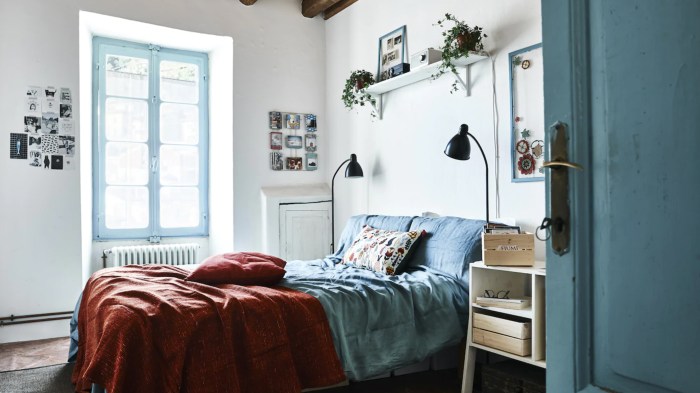
Effective lighting is paramount in achieving the serene and functional atmosphere characteristic of Scandinavian bedroom design. The long, dark winters of Scandinavia necessitate a thoughtful approach to illumination, maximizing natural light while strategically employing artificial sources to create warmth and ambiance. This section explores various lighting styles, layering techniques, and practical tips to optimize lighting in a Scandinavian bedroom.
Three Lighting Styles Suitable for Scandinavian Bedrooms
Three distinct lighting styles, each with its own strengths and weaknesses, can be successfully integrated into a Scandinavian bedroom design. These are ambient lighting, task lighting, and accent lighting. The optimal approach often involves a skillful combination of all three.
Ambient Lighting: This provides overall illumination, setting the mood and general brightness of the room. Think of a softly glowing ceiling fixture or strategically placed wall sconces. Advantages include even illumination and a sense of spaciousness. Disadvantages may include insufficient light for specific tasks and a potential lack of visual interest. Examples include a large, circular pendant light made of natural materials like wood or rattan, or a series of recessed LED downlights offering diffused light.
Task Lighting: Designed for specific activities, this focuses light where it’s needed most. A bedside lamp for reading or a vanity light for applying makeup are excellent examples. Advantages include improved visibility for tasks and reduced eye strain. Disadvantages may include creating localized brightness that disrupts the overall ambiance if not carefully integrated. Consider using adjustable arm lamps with warm-toned LED bulbs near the bed or a sleek, minimalist desk lamp for a workspace within the bedroom.
Accent Lighting: This enhances specific features or artwork, adding depth and visual interest. Picture lights highlighting artwork or strategically placed floor lamps illuminating a textured rug are effective accent lighting choices. Advantages include highlighting architectural details and creating visual focal points. Disadvantages include potential glare if not properly positioned and the possibility of overpowering the ambient lighting if excessively bright.
A strategically placed uplighter near a plant or a small spotlight focusing on a piece of art would serve as an excellent example.
Layering Lighting for a Warm and Inviting Atmosphere
Layering lighting—combining ambient, task, and accent lighting—is crucial for creating a warm and inviting Scandinavian bedroom. This approach allows for flexibility and control over the atmosphere, adapting to different needs and moods throughout the day.
Ambient Lighting: Start with a foundational layer of soft, diffused ambient light. Recessed LED downlights with warm-white (2700-3000K) bulbs offer even illumination without harsh shadows. Alternatively, a large pendant light crafted from natural materials like woven wood or paper can provide a softer, more textural ambient glow.
Task Lighting: Introduce task lighting to address specific needs. Beside each bed, place adjustable table lamps with warm-white LED bulbs. The adjustable arms allow for precise light direction, ideal for reading. A small vanity light with a dimmer switch provides controlled illumination for makeup application.
Accent Lighting: Finally, add accent lighting to highlight architectural details or artwork. Picture lights with adjustable brightness settings can subtly illuminate framed prints or photographs. A floor lamp with a warm-toned bulb placed near a textured rug can create a cozy focal point. The use of dimmers on all lighting layers allows for customized ambiance control. For example, dimming the ambient lighting while brightening the task lighting allows for a comfortable reading environment at night.
Lighting Tips for a Scandinavian Bedroom
Creating a balanced and functional lighting scheme in a Scandinavian bedroom requires careful consideration of several factors.
Prioritize natural light: Maximize natural light by using sheer curtains or blinds that allow ample daylight to filter into the room. This reduces the reliance on artificial light during the day and promotes a sense of spaciousness.
Choose warm-toned light bulbs: Opt for warm-white (2700-3000K) LED bulbs to create a cozy and inviting atmosphere. Avoid cool-white or daylight bulbs, which can feel harsh and sterile.
Incorporate dimmers: Dimmers provide control over the intensity of lighting, allowing for adjustments based on the time of day and desired ambiance. This flexibility is especially valuable in a Scandinavian setting, where daylight hours vary significantly throughout the year.
Consider different light sources: Combine various light sources to achieve a layered and balanced lighting scheme. This could include a combination of ceiling fixtures, table lamps, wall sconces, and floor lamps.
Emphasize natural materials: Select light fixtures made from natural materials such as wood, rattan, or paper to complement the overall Scandinavian aesthetic. These materials contribute to a warm and inviting feel.
Textiles and Accessories in Scandinavian Bedrooms
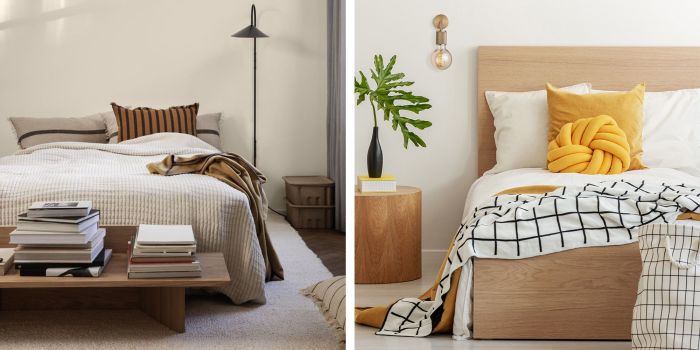
The careful selection of textiles and accessories is paramount in achieving the characteristically serene and inviting atmosphere of a Scandinavian bedroom. These elements contribute significantly to the overall tactile experience and visual appeal, layering warmth and personality onto the minimalist foundation of the design. The focus remains on natural materials, simple patterns, and a muted color palette that fosters a sense of calm and well-being.
Textiles, in particular, play a crucial role in softening the clean lines of Scandinavian furniture and architecture. Their textures introduce a sense of comfort and visual richness, while their colors and patterns subtly enhance the room’s ambiance. The strategic use of textiles can significantly impact the overall feel of the space, transforming it from a starkly minimalist environment into a cozy and inviting sanctuary.
Commonly Used Textiles and Their Characteristics
Several textile types are frequently employed in Scandinavian bedroom design, each contributing unique textural and visual qualities. These choices are often driven by a desire for both aesthetic appeal and practicality. The emphasis is consistently placed on natural fibers known for their breathability and durability.
- Wool throws: Thick, chunky knit wool throws in muted colors like cream, gray, or beige add significant warmth and texture. Their natural fibers provide excellent insulation, making them ideal for colder climates. The texture varies from fluffy and soft to tightly woven and substantial, depending on the knitting technique.
- Linen bedding: Linen sheets and duvet covers are prized for their breathability and ability to regulate temperature. Their slightly textured surface and natural crinkle add a touch of rustic charm. Colors tend towards neutrals like white, light gray, or soft blue.
- Cotton rugs: Cotton rugs, often in flat-weave designs, provide a soft surface underfoot while complementing the overall minimalist aesthetic. Their simple designs and natural color palette ensure they don’t compete with other elements in the room. Durability is a key factor, as they endure daily wear and tear.
- Jute curtains: Jute curtains add a natural, earthy element to the room, allowing diffused light to filter through while maintaining privacy. Their coarse texture contrasts beautifully with the smoother surfaces of other textiles and furniture. The natural color of jute, a light beige or tan, aligns seamlessly with the Scandinavian palette.
Utilizing Textiles to Enhance Ambiance
The strategic placement and selection of textiles are key to creating a warm, comfortable, and visually interesting Scandinavian bedroom. Consider the following approaches:
- Layering textures: Combining different textures, such as a chunky knit throw over a linen duvet cover, adds depth and visual interest without overwhelming the minimalist aesthetic.
- Introducing color subtly: While the overall palette remains muted, introducing pops of color through cushions or a patterned rug can add a touch of personality without disrupting the sense of calm.
- Balancing warmth and coolness: The use of natural fibers like linen and cotton provides breathability, while wool throws and rugs offer warmth and comfort, creating a balanced environment suitable for all seasons.
- Strategic placement: A strategically placed rug can define a seating area, while curtains can soften the hard lines of windows and add privacy.
Scandinavian Bedroom Textile and Accessory Mood Board
Imagine a bedroom bathed in soft, natural light. The walls are painted a gentle, off-white shade, reminiscent of fresh snow. The floor is covered in a large, flat-weave cotton rug in a subtle, heather gray. A linen duvet cover, in a crisp white, is layered with a chunky knit wool throw in a creamy beige. Two simple, linen cushions in a muted sage green add a touch of color.
The windows are dressed with sheer, linen curtains, allowing soft light to filter through. A small, woven basket sits on a bedside table, holding a few carefully selected books. A simple, ceramic vase holds a single, dried branch. The overall effect is one of understated elegance, comfort, and tranquility – a true reflection of Scandinavian design principles.
The color palette is predominantly neutral, with subtle hints of green and beige. The textures are varied, from the soft linen to the chunky wool, creating a visually and tactilely rich experience. The accessories are minimal, chosen for their functionality and aesthetic appeal.
Illustrating Scandinavian Bedroom Styles
The Scandinavian design aesthetic, characterized by its simplicity, functionality, and connection to nature, encompasses a diverse range of styles. While sharing a common thread of light, airy spaces and natural materials, variations exist, leading to distinct interpretations within the broader Scandinavian theme. This exploration will delve into three prominent styles: minimalist, rustic, and modern Scandinavian bedrooms, highlighting their unique characteristics and illustrating them through detailed descriptions.
Minimalist Scandinavian Bedroom
Minimalist Scandinavian bedrooms prioritize functionality and clean lines, eliminating clutter and focusing on essential elements. The emphasis is on creating a sense of calm and spaciousness through a restrained color palette and carefully selected furniture.
| Style | Key Features | Furniture | Textiles and Accessories |
|---|---|---|---|
| Minimalist Scandinavian | Clean lines, uncluttered space, neutral color palette, emphasis on functionality, natural light. | A low platform bed with a simple headboard, a small bedside table with a minimalist lamp, a built-in wardrobe with sleek handles. | A crisp white linen duvet cover, a simple knitted throw blanket in a natural color (such as off-white or light grey), a small, geometric patterned rug. A single piece of abstract art hangs on the wall, perhaps a black and white print. A single potted plant sits on the windowsill. |
| Rustic Scandinavian | Natural materials, warm tones, handcrafted elements, cozy atmosphere, visible textures. | A solid wood bed frame with a slightly more ornate headboard, a repurposed wooden chest of drawers, a sheepskin rug. | Thick woolen blankets in earthy tones, linen curtains with subtle texture, woven wall hangings. A vintage wooden mirror hangs above the dresser, reflecting the light. A collection of candles sits on the bedside table, adding a warm, inviting glow. |
| Modern Scandinavian | Sleek lines, geometric patterns, bold color accents, contemporary furniture, sophisticated simplicity. | A low-profile platform bed with a tufted headboard, a floating nightstand with integrated lighting, a streamlined wardrobe with mirrored doors. | A luxurious velvet throw in a deep teal or mustard yellow, geometric patterned cushions, a modern abstract rug. A sculptural lamp adds a focal point to the room, and a selection of carefully chosen books is displayed on the nightstand. |
Rustic Scandinavian Bedroom
The rustic Scandinavian style embraces the warmth and texture of natural materials, creating a cozy and inviting atmosphere. This style often incorporates handcrafted elements and vintage pieces, adding character and personality to the space. The overall feeling is one of relaxed comfort and connection to nature.
Modern Scandinavian Bedroom
Modern Scandinavian bedrooms blend the simplicity of traditional Scandinavian design with contemporary elements. This style features sleek lines, geometric patterns, and carefully selected bold color accents, creating a sophisticated and stylish space. The emphasis remains on functionality, but with a more contemporary and refined aesthetic.
Ultimate Conclusion
Creating a Scandinavian bedroom is more than just selecting a few key pieces; it’s about curating an environment that fosters well-being and promotes restful sleep. By understanding the interplay of color psychology, the strategic use of natural light and texture, and the careful selection of furniture and textiles, you can transform your bedroom into a tranquil retreat. The minimalist elegance of Scandinavian design, grounded in functionality and a connection to nature, provides a timeless and adaptable framework for creating a space that truly reflects your personal style while prioritizing your comfort and well-being.
Remember, the goal is to craft a space that feels both inviting and restorative, a sanctuary where you can unwind and recharge.
Quick FAQs
What are some budget-friendly ways to incorporate Scandinavian design into my bedroom?
Opt for affordable natural materials like pine wood instead of oak. Source secondhand furniture, repaint existing pieces in a Scandinavian palette, and utilize affordable textiles like linen or cotton blends. DIY projects like painting a simple headboard or creating a macrame wall hanging can add unique touches without breaking the bank.
How can I incorporate Scandinavian style into a small bedroom?
Maximize natural light with sheer curtains. Choose light-colored furniture and walls to create an illusion of spaciousness. Use multi-functional furniture like ottomans with storage. Keep the space clutter-free and focus on essential pieces only.
Are there any specific plants that complement a Scandinavian bedroom aesthetic?
Snake plants, ZZ plants, and peace lilies thrive in low-light conditions and add a touch of greenery. Their clean lines and simple forms complement the minimalist aesthetic. Consider placing them on shelves or windowsills to maximize light exposure.
How do I maintain the cleanliness of natural materials in a Scandinavian bedroom?
Regular dusting and vacuuming are crucial for maintaining the appearance of natural materials. Use appropriate cleaning products for specific materials (e.g., wood polish for wooden furniture, specialized cleaners for textiles). Avoid harsh chemicals that could damage the materials.

